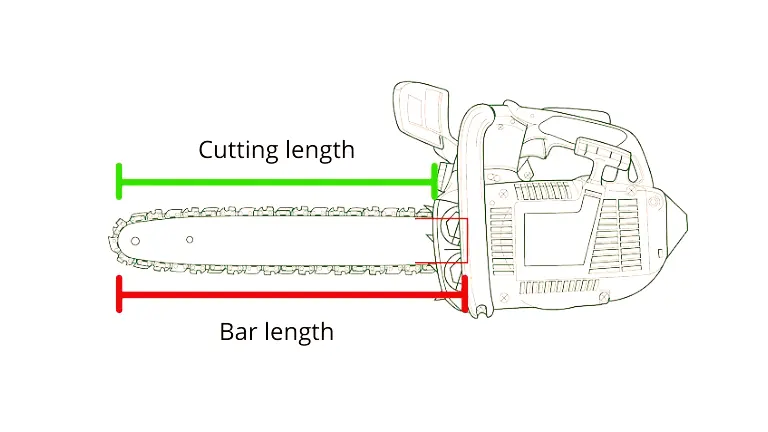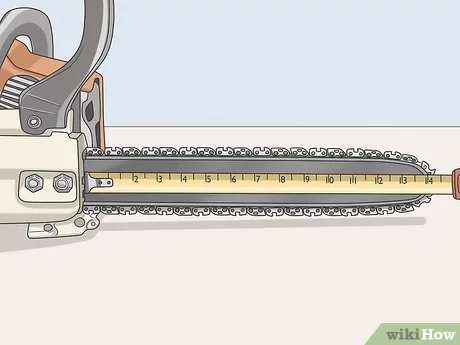Measuring the bar length on a chainsaw is simple but important. It helps ensure proper maintenance and replacement.
Chainsaws are powerful tools for cutting wood and other materials. Knowing the bar length is vital for safety and efficiency. The bar length affects the chainsaw’s performance and suitability for different tasks. This guide will explain how to measure the bar length on your chainsaw accurately.
Whether you’re a beginner or an experienced user, learning this skill can improve your chainsaw’s performance. Let’s dive in and make sure your chainsaw is always ready for the job.

Credit: www.youtube.com
Tools Needed
Measuring the bar length on a chainsaw is essential for its maintenance. Knowing the correct tools for the job makes the process straightforward and hassle-free. Here’s a detailed guide on the tools needed to measure your chainsaw’s bar length accurately.
Essential Tools
To measure the bar length of your chainsaw, you need a few key tools. First, grab a measuring tape. This will help you get precise measurements. Next, you will need a marker to note down the measurements on paper.
A ruler can also be handy. It helps double-check the measurements. Lastly, ensure you have a notepad or a piece of paper. This is where you will jot down the measurements for future reference.
Optional Tools
While not necessary, some optional tools can make the task easier. A digital caliper is one such tool. It provides highly accurate measurements. This can be useful for more advanced users.
Another optional tool is a flashlight. It helps you see better in low-light conditions. Also, a small brush can help clean the bar before measuring. Dirt and debris can affect the accuracy of your measurement.

Credit: forestry.com
Safety Precautions
Safety is the most important part of using a chainsaw. Before you measure the bar length on a chainsaw, follow these safety steps. This will help avoid injuries and ensure a smooth process.
Protective Gear
Always wear protective gear when working with a chainsaw. This includes:
- Helmet: Protects your head from falling debris.
- Gloves: Shields your hands from cuts and vibrations.
- Goggles: Keeps your eyes safe from sawdust and splinters.
- Ear Protection: Prevents hearing damage from the loud noise.
- Chainsaw Chaps: Special pants that protect your legs from chainsaw cuts.
Safe Work Environment
A safe work environment is key to preventing accidents. Ensure the following:
- Clear Area: Remove any obstacles or debris from your workspace.
- Good Lighting: Make sure the area is well-lit.
- Stable Ground: Stand on firm, even ground to maintain balance.
- No Distractions: Focus on the task without interruptions.
- Emergency Plan: Have a first aid kit and emergency contact ready.
Following these safety precautions will make measuring the bar length of a chainsaw safer and easier.
Preparing The Chainsaw
Before measuring the bar length on a chainsaw, preparation is crucial. Proper preparation ensures accurate measurements and safety. Follow these steps to prepare your chainsaw for measurement.
Cleaning The Chainsaw
A clean chainsaw is essential for accurate measurement. Remove dirt, debris, and sawdust from the chainsaw. Use a brush or compressed air to clean the bar and chain. Ensure the chainsaw is free from oil and grime. A clean chainsaw provides a clear view of the bar and chain.
Securing The Chainsaw
Securing the chainsaw prevents movement during measurement. Place the chainsaw on a flat, stable surface. Use clamps or a vise to hold the chainsaw in place. Ensure the chainsaw is stable and will not move. Stability is key for an accurate measurement.

Credit: www.youtube.com
Measuring The Bar Length
Knowing the correct bar length of your chainsaw is essential. It helps in choosing the right replacement chain. It also ensures optimal performance. Here’s a step-by-step guide to measure the bar length accurately.
Removing The Chainsaw Bar
First, ensure the chainsaw is off and unplugged. Safety is important. Wear protective gloves to avoid cuts. Use the right tools to remove the bar. This usually involves loosening nuts or screws. Carefully take off the cover. This exposes the chainsaw bar and chain.
Using A Measuring Tape
Once the bar is exposed, take a measuring tape. Start at the base of the bar. Measure to the tip. Note the length in inches. This is your bar length. Simple, but crucial for proper chainsaw maintenance.
Double-checking Measurements
When measuring the bar length on a chainsaw, it’s crucial to ensure accuracy. Double-checking your measurements can save you time and avoid potential mistakes. This section will guide you through the steps to confirm your measurements effectively.
Confirming Accuracy
To confirm the accuracy of your chainsaw bar length measurement, follow these steps:
- Lay the chainsaw on a flat surface. Ensure it is stable and safe to measure.
- Measure from the base to the tip. Use a measuring tape to measure from the point where the bar meets the chainsaw body to the end of the bar.
- Repeat the measurement. Double-check by measuring again to ensure the same result.
Common Mistakes
Avoiding common mistakes is key to getting an accurate measurement. Here are some errors to watch out for:
- Measuring the entire bar: Only measure the part of the bar that is usable, not the part inside the chainsaw.
- Incorrect starting point: Start measuring from the base of the bar where it exits the chainsaw.
- Using a faulty tape measure: Ensure your measuring tool is accurate and not worn out.
By following these tips and double-checking your measurements, you can accurately determine your chainsaw bar length.
Recording The Measurements
Recording the measurements of your chainsaw bar length helps in maintaining accurate records. This ensures you always know the size of the bar. It is especially useful when you need to replace or purchase a new chain. Proper documentation also aids in efficient maintenance and safety checks.
Documenting Bar Length
Start by writing down the total length of the bar. Use a notebook or a digital tool for this. Clearly label each measurement with the date and any specific notes. For example, note if the measurement was taken after a significant usage period.
Keep this information in an easily accessible place. It should be somewhere you can quickly refer to when needed. This practice helps in tracking wear and tear over time. It also ensures you have the correct size for replacements.
Maintaining Records
Maintaining records involves more than just jotting down measurements. Regularly update your records with each new measurement. This helps in identifying any changes in the bar length over time. It also aids in spotting potential issues before they become major problems.
Having a consistent record-keeping habit is key. This helps in prolonging the life of your chainsaw. It also enhances the efficiency of your chainsaw operations. Plus, having detailed records can be invaluable during warranty claims or repairs.
Frequently Asked Questions
How Do I Measure A Chainsaw Bar Length?
To measure a chainsaw bar length, use a tape measure. Measure from the base of the bar to the tip. This gives you the effective cutting length.
What Tools Do I Need To Measure A Chainsaw Bar?
You only need a tape measure to accurately measure your chainsaw bar length.
Why Is It Important To Measure Chainsaw Bar Length?
Measuring the chainsaw bar length ensures you buy the correct replacement chain and bar.
Can I Measure The Bar Without Removing It?
Yes, you can measure the chainsaw bar without removing it from the chainsaw.
Conclusion
Measuring a chainsaw bar length is simple and essential. First, gather your tools. Next, measure from the chainsaw tip to the base. Use a measuring tape for accuracy. Understanding bar length helps in buying the right chain. Regular measurements ensure chainsaw efficiency.
Keep your chainsaw in top shape with these easy steps. Always prioritize safety during measurements. Proper maintenance extends your chainsaw’s lifespan. Now you can confidently measure your chainsaw bar length. Happy sawing!
